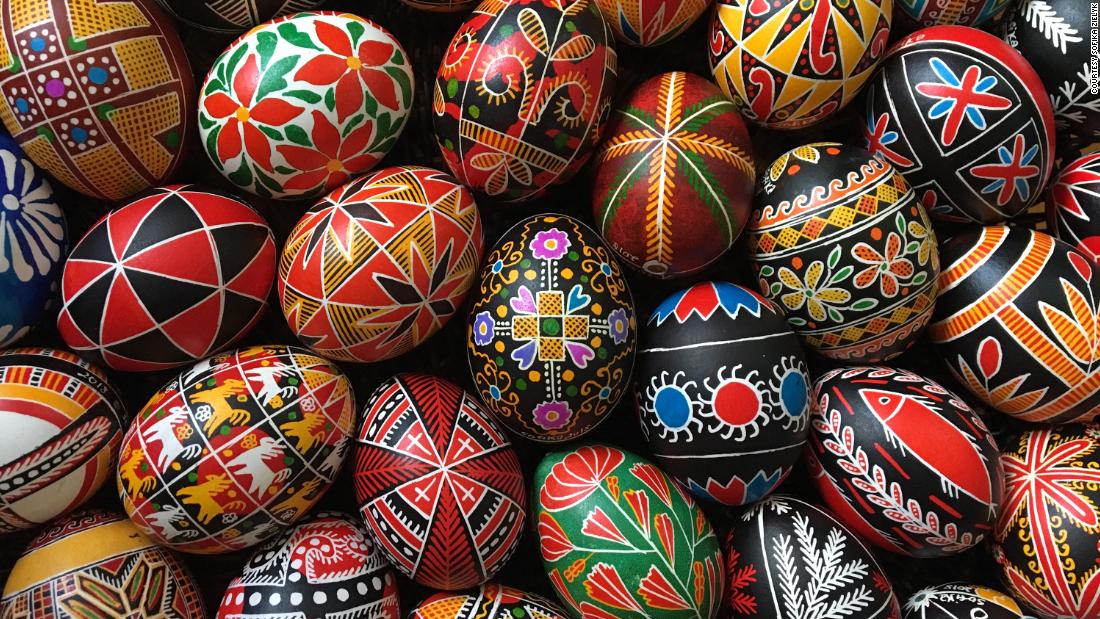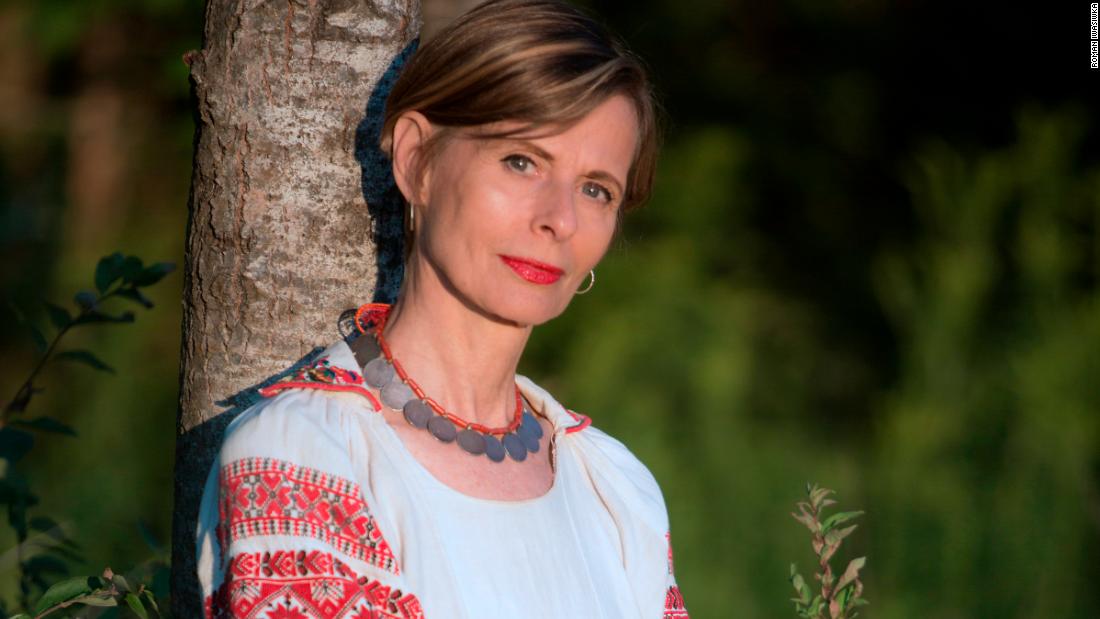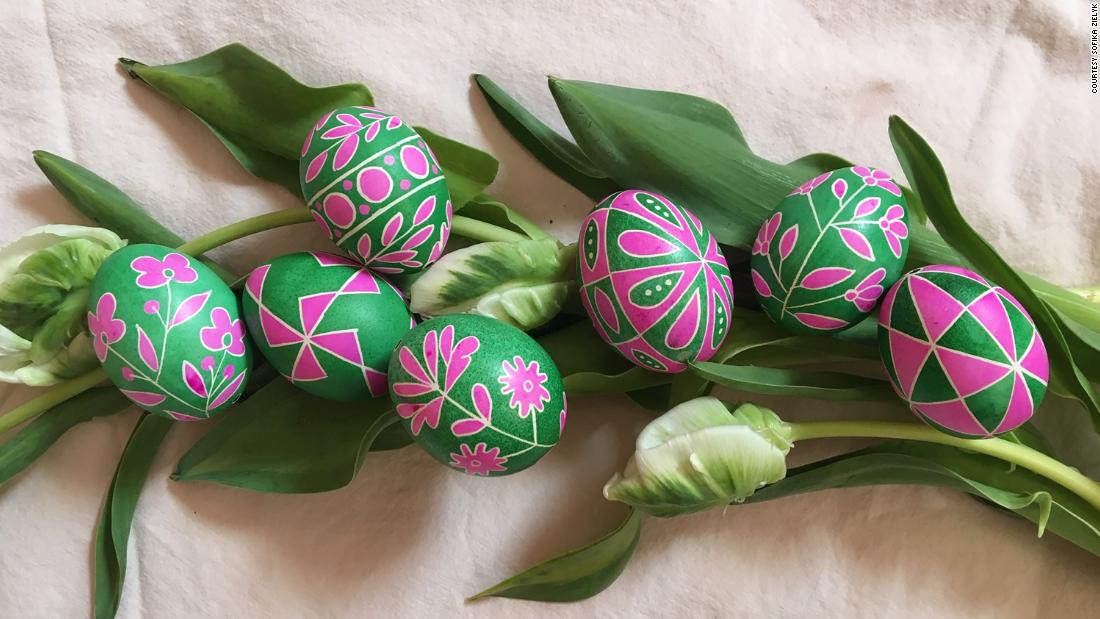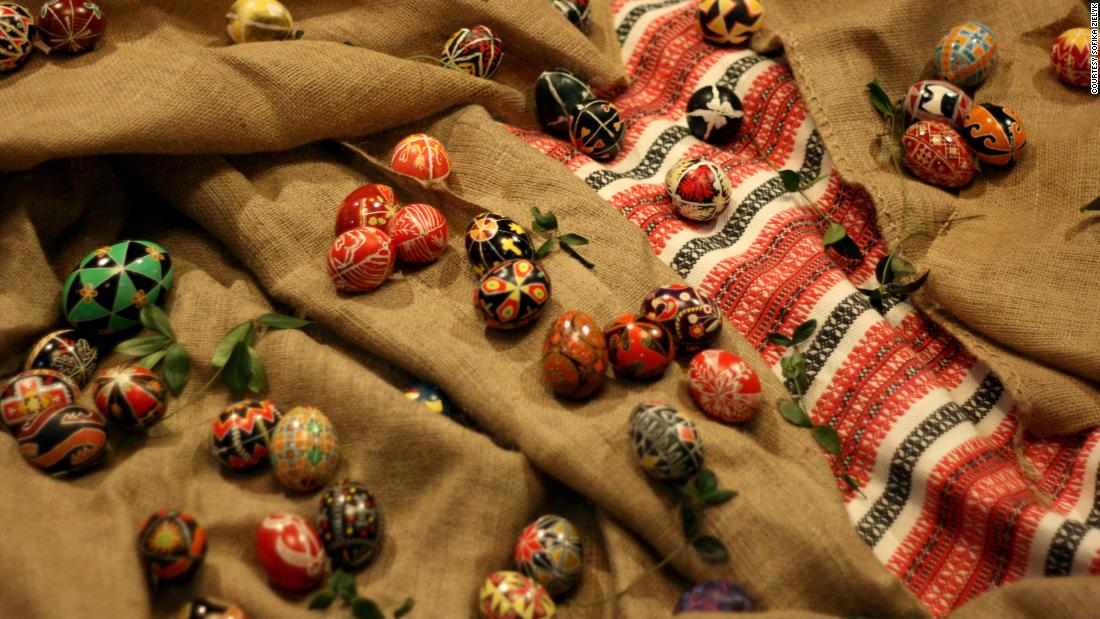
Ukrainian Easter Eggs from the exhibition "The Pysanka: A Symbol Of Hope," at the Ukrainian Institute of America in New York.
By Stephanie Griffith
Sat April 16, 2022
Stephanie Griffith is an opinion editor at CNN.com.
(CNN)An American-born daughter of Ukrainian refugees, Sofika Zielyk has dedicated her life to keeping the heritage of her parents' homeland alive. The artist and ethnographer specializes in creating and curating pysanky -- traditional Ukrainian Easter eggs decorated in painstaking detail, each one a dazzling gem.
The art of creating pysanky goes back centuries: Patterns are applied with a stylus onto an egg with melted beeswax. The egg is repeatedly dipped in colored dye as the design becomes increasingly intricate. What emerges is a fragile, exquisite work of art.

Artist Sofika Zielyk
As Russian President Vladimir Putin presses forward with his violent campaign of bombarding Ukrainian towns and cities in a bid to dominate Ukraine's people and erase its culture, Zielyk and others in the Ukrainian diaspora are embracing pysanky as more than a springtime ritual of renewal. They say it is a symbol of Ukrainian resilience, and that the country will survive.
A breadth of styles found in pysanky can be seen in the photos accompanying this article. An exhibit of pysanky sent to Zieklyk by Ukrainians from around the world is currently being shown at the Ukrainian Institute of America in New York City. CNN spoke to her about the art and the cultural significance of making pysanky. This interview has been lightly edited for clarity.
CNN: How did you get started creating pysanky?
Sofika Zielyk: My two sisters, my parents and I lived in a tiny New York apartment [when I was growing up]. As I was falling asleep at night, I would watch my mother making pysanky. Everything was dark except the candle flame, which you need in order to create these eggs because you have to melt the wax over the flame.
It was so mystical and so beautiful. I was about five years old. I asked my mother if I could create a pysanky. I remember sitting on her lap, and she helped me hold the stylus. My first egg had little dots, lines and stars. And that's the way I started.
This is an extremely ancient tradition that originated in Ukraine and it was passed down through centuries, mother to daughter. Pysanka is the symbol of rebirth.

Ukrainian Easter Eggs from the exhibition "The Pysanka: A Symbol Of Hope," at the Ukrainian Institute of America in New York.
I always made them during the Easter season, and eventually a hobby turned into a profession. When I started researching the tradition, I realized that this was just more than pretty decorated eggs. It has a history of a whole nation.
CNN: What is the significance of this art form in this current moment, when Russia is attempting to destroy Ukraine's culture?
Zielyk: It has a very special significance. Right now, when there is attempted genocide in the country of Ukraine, my ancestral homeland, this is a very important thing to do. The egg is so fragile and yet the tradition has not left -- the tradition was not killed throughout the centuries.
The annihilation of Ukrainian culture has been going on for [centuries]. Whether it's the Russian Empire, whether it's the Soviet Union, or the Russian Federation, it is the same aggressor and they have the same goal.
These eggs were started in pre-Christian times as a spring ritual to bring back the sun after a long winter. People chose an egg as a gift to the sun, because the yolk reminded them of the sun. They thought if they held the egg in the palm of their hand, they could harness a little bit of the power of the sun. Also, the rooster comes out of the chicken egg, and the rooster was the sun god's chosen creature, because when the rooster crows, the sun comes out.
So people gave the gift of an egg -- but they also included symbols of tribute and symbols of prayer in the hope that the sun god would grant their wishes. These pagan beliefs came to be adapted to Christianity. So it was no longer the sun god coming back from a long winter, but the resurrection of Christ from the dead.
CNN: How did the tradition come to this country?
Zielyk: During the late 19th and early 20th centuries, people emigrated to different countries from Ukraine. And then, right after World War II, refugees came to the United States. And two of these refugees were my parents. I am a very proud first-generation American daughter of Ukrainian refugees. My parents and their parents fled the Nazis and the Soviets.
People were thinking that Ukraine would not exist. Or that it would be swallowed up by the Soviet Union -- which it was. But they continued to practice their customs and traditions.
Immigrants and refugees, who came to different countries from Ukraine brought this tradition with them. And it was here in the diaspora that it was for safekeeping. And it was kept safe and it flourished here.

Ukrainian Easter Eggs from the exhibition "The Pysanka: A Symbol Of Hope," at the Ukrainian Institute of America in New York.
CNN: The images of destruction in Ukraine are heartbreaking. But you seem hopeful about its resurgence from the ruins.
Zielyk: When the war started, I was in shock. I was in disbelief, sadness -- and then anger set in and I felt like I had to do something. I realized that pysanky and cultural diplomacy is my weapon.
So I put a call out to social media and asked anybody who's of Ukrainian descent-- anybody who cares -- to create a pysanky and send it to the Ukrainian Institute. And it is an installation that is constantly changing because more eggs are arriving every day from all over the world.
It is the ancestral, primal, symbolic response to the aggressor. It is our way of saying that we are here, we have been here for centuries and we are not going anywhere.
Get our free weekly newsletter
CNN: What will become of all of these eggs once the exhibit is over?
Zielyk: When the war ends, all the eggs that have been coming from all over the world will be transported to Ukraine. Because the egg is a symbol of rebirth, they will symbolically help with the rebirth.
The pysanky will be buried in the ground in all the cities that have been destroyed so that we can help with the delicate, humble yet extremely powerful task of rebuilding.
No comments:
Post a Comment